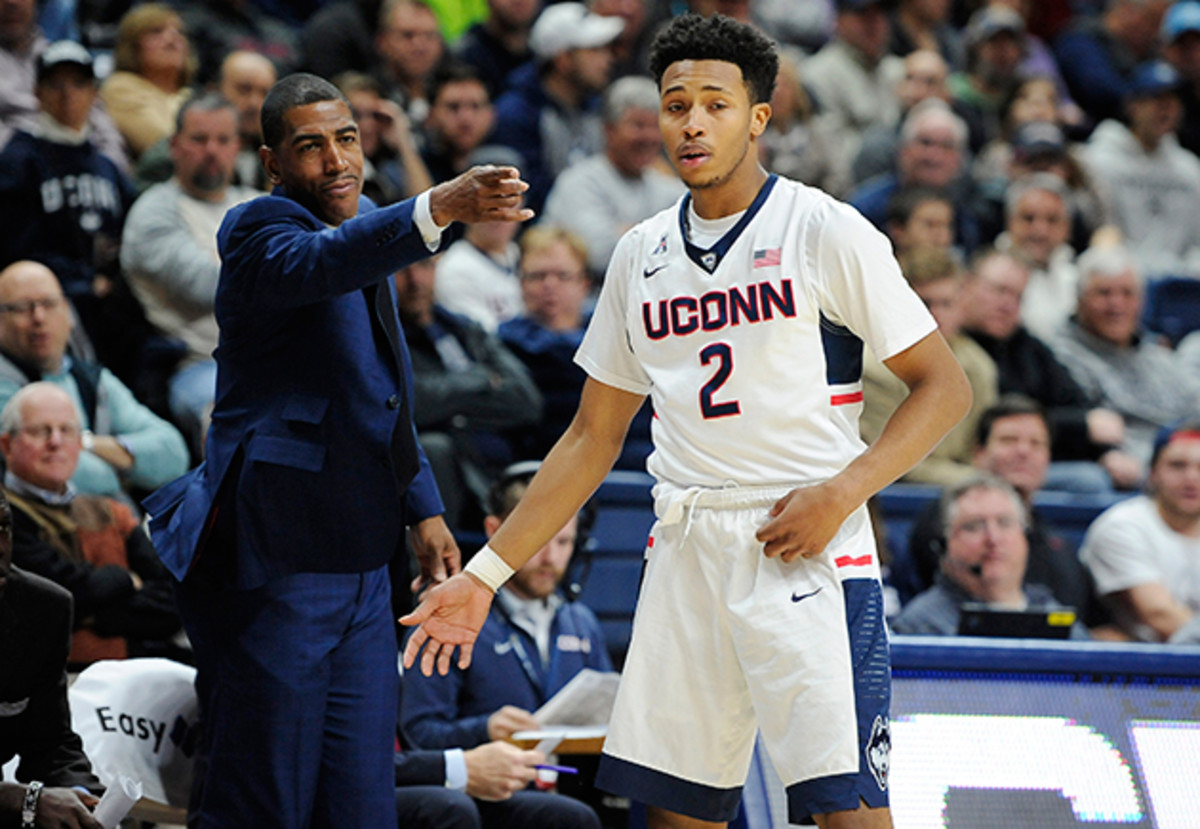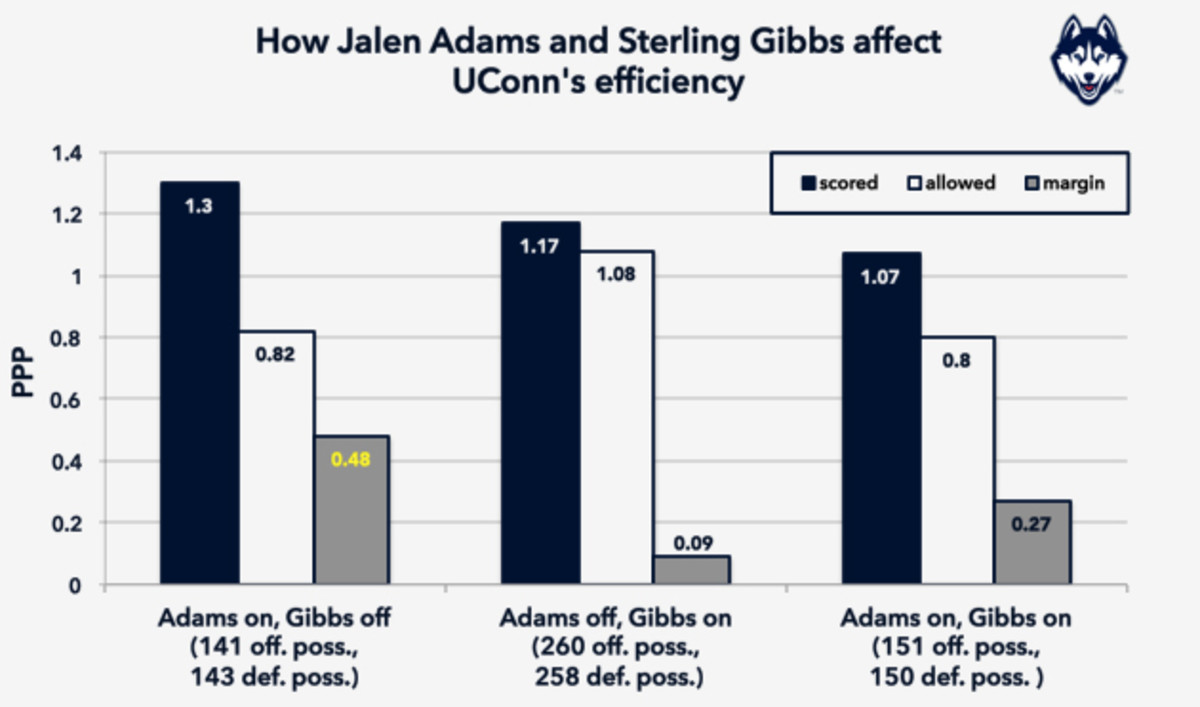Jalen Adams aiming to become the next great Connecticut guard

Shabazz Napier. Kemba Walker. Khalid El-Amin. Ray Allen. They are a few names on the list of transcendent Connecticut guards. The group’s growth is fueled by a simple guiding principle: Versatility is more important than position. When Huskies coach Kevin Ollie was recruiting Jalen Adams, it did not really matter whether or not he classified as a “true” point guard. The distinction has blurred over time, becoming less restrictive to scoring-minded backcourt players. And for Ollie, it’s less a rigid category denoting tactical specifics than a trivial descriptor. “When you say point guard, it really don’t mean anything to me,” he says.
The implication is clear: Where you can play on the court is secondary to whether you can play. Adams could before he began ninth grade, when Ollie first saw him, and, the freshman is now a key contributor on a UConn team that could win the American Athletic Conference. While Saturday’s 20-point win over Ohio State improved the Huskies to a modest 6–3, they rank as one of the nation’s top-25 teams on kenpom.com. Adams’s statistics—6.4 points on 39.7% shooting from the field in 20.3 minutes per game—are underwhelming and his profile remains relatively low, but expect that to change soon.
If this season’s freshman class lags behind last season’s in terms of star power, Adams is one of the few outside of Baton Rouge, La., who deserves a closer look before being labeled an underachiever. He has played his way into a loaded perimeter rotation that also includes Seton Hall graduate transfer Sterling Gibbs, skilled scorer (and NC State transfer) Rodney Purvis and conference player of the year candidate Daniel Hamilton. Adams has already gotten better since the start of the season, and he should ascend UConn’s backcourt pecking order in the coming months if he stays on this growth curve.
Because of UConn’s reputation as a “Guard U” of sorts, it is tempting to anoint Adams as the next in a long line of incandescent talents who helped transform the program from a regional brand in the Yankee Conference into an East Coast powerhouse with national cachet. The comparisons are even more difficult to resist because of where Adams comes from: the same Boston neighborhood, Roxbury, that produced Napier. Yet while Adams welcomes being mentioned in the same breath as a national champion and first-round NBA draft pick, he pushes back against the notion that they resemble each other beyond their shared geography.
All the right moves: Monmouth hoops making noise on court & on sidelines
Adams believes he excels at getting to the basket, whereas Napier was “more of, like, a pick and roll, shoot the three, one-on-one type of guy.” The backcourt arrangement Adams navigated in high school and in grassroots basketball may have helped to shape his style. At Cushing Academy in Ashburnham, Mass., as well as the Mass Rivals program, Adams played alongside Kaleb Joseph, a former top-60 point guard recruit who is now getting limited minutes as a Syracusesophomore. So when talent evaluators scouted Adams, it was unclear whether he projected as a point guard in college. The recruiting service Scout.com, for instance, described him as “probably a true combination guard.”
According to Mass Rivals coach Vin Pastore, Adams possesses what he believes are the “inherent characteristics” required to be a point guard—“you just can’t become a point guard,” Pastore says—and he spent more time at the position later in his prep career. While he was “very much still a scoring point guard,” Adams adjusted his attacking mindset, Pastore says, to allow for a greater emphasis on facilitating scoring opportunities for others. “He’s got a great understanding of the game, and he sees the game,” Pastore adds. “Although he plays fast, he slows the game down in his mind. He has great vision, and always did.”
Adams legitimized his prospects as a top-flight Division I point guard during his postgraduate year at Brewster Academy in Wolfeboro, N.H. Though the Bobcats counted multiple high-level prospects in their backcourt—including Louisville’s Donovan Mitchell and Arizona’s Justin Simon—coach Jason Smith says it became clear to him during fall workouts that Adams would play the one, based on what Smith described as a “high basketball IQ” and “great understanding of the game.” It also was easier for Adams to suppress the urge to call his own number because he was surrounded by so many other capable scorers.
Another factor that Adams considered in focusing on honing his point-guard skills was his professional future. Adams knew he could handle the position and realized that, at 6'3"’, his odds of cutting it as a two in the NBA were slim. “I have the tools and stuff to play point guard, so why not just work on that?” he remembers thinking.

Adams did not grow up a Connecticut fan, per se, but it was one of several local programs he followed. He appreciated UConn’s track record of developing guards into college stars and NBA draft picks, and was particularly taken with Walker’s star turn. Adams ultimately pledged to the Huskies over finalists Louisville and Kansas in June 2014, less than three months after Napier pushed UConn past Kentucky in the national title game, and less than a week after he was selected with the 24th pick of the NBA draft.
Adams led Brewster to a second consecutive national championship last season and arrived in Storrs, Conn., with the possibility of logging major minutes right away with the departure of 2015 leading scorer Ryan Boatright. But Adams’s playing-time outlook changed when the Huskies beat out a host of programs vying to land Gibbs, who left Seton Hall after it posted a 6–12 record in Big East play in 2014–15 and missed the NCAA tournament for the ninth consecutive season amid reports of locker room strife (fellow guard Jaren Sina departed during the season).
Gibbs, who says one of the main reasons he chose UConn was that it offered a “family environment,” gave the Huskies a talented option at point guard who ranked seventh in the Big East by knocking down 42% of his threes during conference play last season while with the Pirates. Adams was not blindsided by the addition of Gibbs, nor did he resent the prospect of having another starting-caliber guard in UConn’s backcourt. Adams and Gibbs say they discussed how they could operate in tandem, and they did not foresee any gripes over how scoring and ball-handling would be divided between the two. “No one’s really selfish, so we’re all going to get ours,” Adams remembers telling Gibbs.
Bidding goodbye to Bo Ryan and his unforgettable run with the Badgers
Adds Gibbs, “We just talked about how previous guards worked together throughout college basketball—two point guards playing at the same time. We felt like we would be able to do that and be able to create for each other and help each other out.”
Ollie stresses that he’s not a “traditional” coach who adheres to positional conventions and plainly described the impetus behind bringing in Gibbs to a roster that already was adding a five-star point guard recruit. “You need talent to win games,” Ollie says. “So you can do all the coaching you want to, but you need multiple guys that can score, multiple guys that can play.” Gibbs is identified as a point guard, but Ollie points out that he differs from the prototypical table-setters to which the label is often applied. “Sterling was not just [a] traditional, let-me-put-him-in-a-box point guard,” Ollie says. “He’s different—he’s a shooter, he’s a scorer.”
While Gibbs functions as UConn’s point guard when Adams is on the bench and vice versa, they both shoulder certain responsibilities when sharing the floor. Ollie says he’d prefer that Adams initiate the offense in those lineups, but Adams also must know how to operate as an off-guard. Whereas Adams excels at attacking off the bounce, Gibbs is a better perimeter shooter. Adams can collapse the defense with dribble penetration, then feed Gibbs for clean three-point looks. To wit: Gibbs has scored 1.45 points per possession on spot-ups this season, which ranks in the 96th percentile nationally, according to Synergy Sports.
Adams has some work to do on his jumper—he’s hit only 26.7% of his threes this season—but he’s already a terror in transition. Adams is so quick that sometimes the tricky question of how to create shots against a set defense is obviated before Ollie even has to consider it. Check out this sequence against Sacred Heart, in which Adams intercepts a pass on the perimeter and drives in for a powerful, one-handed dunk.
UConn has scored more efficiently and allowed fewer points per possession so far this season when Adams is on the court and Gibbs is off than when Gibbs is on the court and Adams is off. The data, from Hoop Lens, is limited, and these numbers could change if Gibbs starts making threes at a rate on the order of what he managed during conference play the last two seasons (42% and 45.2%, respectively, compared with 34% this season). Still, the evidence suggests the calls for Adams to receive more playing time at Gibbs’s expense are not unfounded. The Huskies have been O.K. when Gibbs and Adams play together, and Ollie says he likes the arrangement because of the way it spreads the floor.
Setting aside Adams and Gibbs, UConn has an abundance of perimeter firepower that it can use in different lineups. Hamilton has assisted on a larger percentage of the Huskies' buckets (31%) than any teammate and can get by defensively at the four, and senior Omar Calhoun led the team with 14 points on 5-for-5 shooting in the 75-55 win over the Buckeyes.

UConn has used a two-point guard set up to great effect in the past. But while Napier was a senior and Boatright was a junior when they led the Huskies to the program’s fourth national title in 2014, both Adams and Gibbs are both in their first season in Storrs. “They’re all different players,” Ollie says. “They’re going to write their own storyline this year, and it’s not finished writing—the ink is not dried on that paper yet.” Assuming he returns as a sophomore, Adams will form half of another point guard duo, in what Ollie thinks will be a “real dynamic backcourt” with top-40 recruit Alterique Gilbert.
In 2015–16, Adams can propel UConn to its most successful season since Napier left school. Bigger picture, Adams has the potential to finish his college career in the same lofty place as the other guard whom the Huskies plucked from the same section of Beantown—atop a ladder, cutting down a net.
